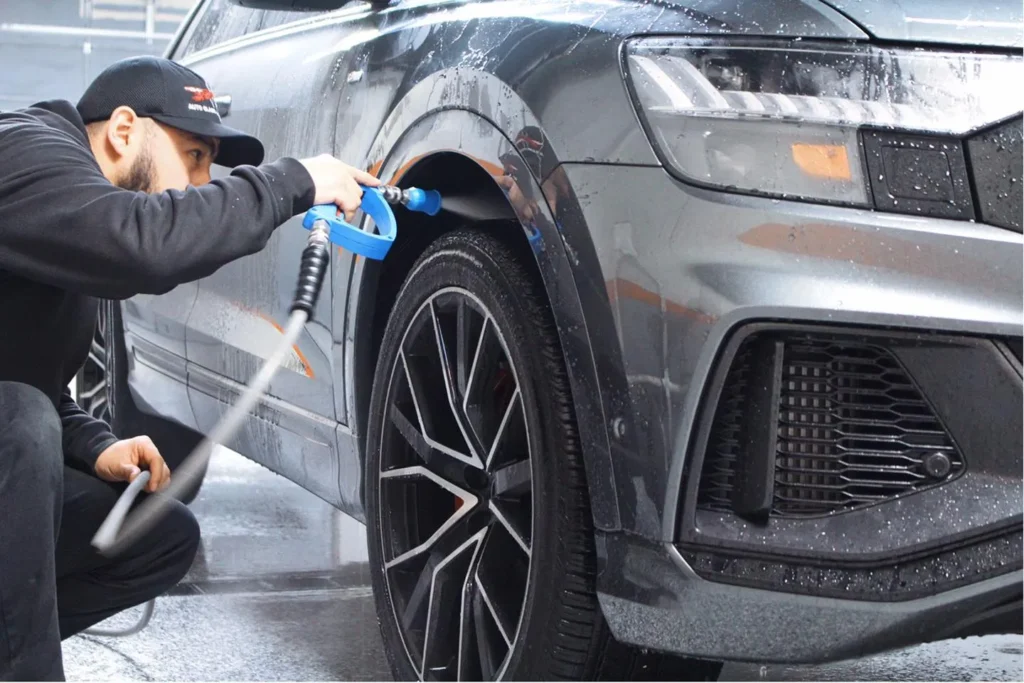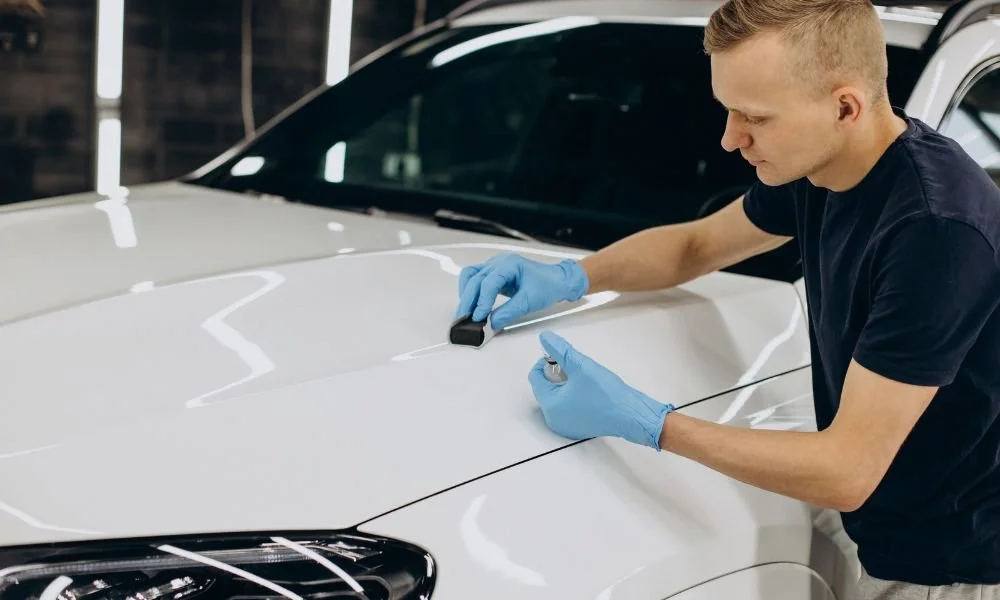Every car owner wants a showroom-quality finish that lasts for years. Applying a ceramic coating is one of the most effective ways to protect paint, improve gloss, and prevent damage from environmental hazards. Before applying the coating, understanding the what the steps are to prepare a car for ceramic coating is crucial. Proper preparation ensures the coating bonds well and provides long-term protection. At Adam’s Detailing and Coatings, our experts emphasize the importance of paint correction, clay bar treatment, surface decontamination, and scratch prevention before applying any ceramic coating. These steps prevent swirl marks, oxidation, and trapped contaminants while creating a flawless, smooth surface for maximum coating adhesion and durability.
Understanding Ceramic Coating and Its Benefits
Ceramic coating is a liquid polymer applied to the paint surface of your car. Once cured, it forms a protective layer that repels dirt, water, and UV rays while enhancing gloss and depth. Unlike traditional wax or sealants, ceramic coatings create a chemical bond with the paint, ensuring long-lasting protection and durability. Many car enthusiasts rely on ceramic coatings for hydrophobic properties, scratch resistance, chemical resistance, and improved shine. Proper preparation directly impacts how effective the coating will be. Even minor imperfections or residues left on the paint can cause the coating to bond unevenly, reducing its lifespan. Adam’s Detailing and Coatings always stresses preparation as the key to success.
Comprehensive Vehicle Cleaning

The first step in preparing a car for ceramic coating is thorough cleaning. A deep wash removes surface dirt, road grime, and oils that can prevent proper coating adhesion. Experts recommend using the two-bucket method and a pH-balanced car shampoo for best results. Don’t forget wheels, tires, and lower panels where contaminants accumulate. After washing, the vehicle should be dried with microfiber towels to prevent water spots. Next, a clay bar treatment is applied to remove bonded contaminants invisible to the naked eye. Proper cleaning ensures a smooth surface for coating, enhances gloss, and reduces the risk of scratches forming under the ceramic layer.
Paint Correction
Paint correction is essential to remove scratches, swirl marks, and oxidation. Polishing the vehicle creates a flawless surface that allows the ceramic coating to bond evenly. Professionals often use dual-action polishers and compounds of varying strengths depending on the paint’s condition. This process not only improves the car’s appearance but also ensures the coating protects the paint effectively. Skipping paint correction risks trapping imperfections under the coating, making them permanent. Many car owners rely on Adam’s Detailing and Coatings for professional paint correction, ensuring every panel is free of defects before applying a ceramic coating.
Surface Decontamination
After paint correction, surface decontamination is crucial. Residual oils, polishing compounds, or environmental contaminants can interfere with coating adhesion. Isopropyl alcohol (IPA) sprays are commonly used to wipe down the paint and remove any residues. This ensures the surface is completely clean for maximum bonding. In some cases, iron removers or detailing clay may also be applied to tackle stubborn contamination. Proper surface decontamination guarantees long-lasting protection, enhanced hydrophobic properties, and smoothness, allowing the ceramic coating to perform at its best.
Masking and Environmental Preparation
Before applying the ceramic coating, areas like rubber trims, plastic edges, and badges should be masked to prevent chemical bonding. It’s also important to work in a dust-free, temperature-controlled indoor environment. Proper lighting ensures every panel is coated evenly without streaks or missed spots. Professionals at Adam’s Detailing and Coatings follow strict masking and environmental protocols to guarantee a perfect application every time. This preparation helps maintain a flawless finish and ensures the coating provides optimal protection, scratch resistance, and shine.
Applying Ceramic Coating

Applying ceramic coating requires patience and precision. Using an applicator pad, technicians apply small sections at a time, spreading the coating evenly across the surface. Following manufacturer guidelines regarding curing times, layers, and wiping excess product is crucial. Proper application enhances chemical resistance, scratch prevention, hydrophobic properties, and UV protection. Rushing this step or applying too much product can create streaks or uneven coverage. Experienced professionals ensure the coating is applied systematically to achieve a long-lasting, glossy, and protected finish.
Curing and Maintenance
Once applied, ceramic coatings require proper curing. Depending on the product, this can take from a few hours to several days. During this period, the vehicle should avoid water, direct sunlight, and environmental exposure. Proper curing ensures maximum bonding and durability. After curing, regular maintenance using pH-neutral soaps and gentle washing techniques preserves the coating’s hydrophobic properties and gloss. Routine inspections and touch-ups maintain the scratch resistance, shine, and long-term protection of the coating. Following these steps ensures your vehicle remains protected and visually stunning for years to come.
Common Mistakes to Avoid During Preparation
- Skipping paint correction – leaves imperfections under the coating.
- Incomplete cleaning – residual dirt prevents proper bonding.
- Ignoring environmental factors – dust, sunlight, or wind can ruin the finish.
- Applying excess coating – leads to uneven layers or streaks.
- Rushing curing process – reduces coating durability and lifespan.
Avoiding these mistakes ensures maximum coating performance, long-term protection, and a flawless finish.
Additional Tips for Maximum Protection
- Use quality tools and products: Avoid cheap polishes or applicators.
- Follow product instructions strictly: Each coating has unique curing and application requirements.
- Consider professional services: Experts like Adam’s Detailing and Coatings can achieve perfect results.
- Regular maintenance: Even ceramic coatings require gentle washing and occasional touch-ups.
- Protect vulnerable areas: Avoid applying coating to rubber, plastic, or decals unless compatible.
These small actions help extend the life of the coating and maintain a hydrophobic, scratch-resistant, and glossy surface.
Conclusion
Knowing what the steps are to prepare a car for ceramic coating is essential for achieving maximum protection, gloss, and durability. From thorough cleaning and paint correction to surface decontamination, masking, application, and proper curing, each step contributes to the coating’s long-term performance. Skipping or rushing any stage can compromise results and reduce longevity. Professional detailing services, like those offered by Adam’s Detailing and Coatings, ensure meticulous execution, flawless finish, and long-lasting protection. By following these steps and maintaining the coating regularly, car owners can enjoy a durable, visually stunning finish that protects their vehicle against environmental damage and enhances overall aesthetic appeal.
Frequently Asked Questions (FAQ)
How long does ceramic coating last?
It generally lasts 2 to 5 years, depending on care and maintenance.
Can I apply ceramic coating myself?
Yes, but professionals ensure consistent application and long-lasting results.
How often should a coated car be washed?
Wash every two weeks with pH-neutral shampoo to maintain protection.
Will scratches remain after coating?
Minor scratches may be polished, but deep scratches require professional repair.
Is applying multiple layers necessary?
Multiple layers improve durability, gloss, and hydrophobic properties significantly.
